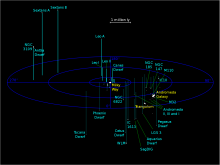Listen to today's episode of StarDate on the web the same day it airs in high-quality streaming audio without any extra ads or announcements. Choose a $8 one-month pass, or listen every day for a year for just $30.
You are here
Getting Bigger
The Northern Cross stands in the northwest this evening, with the “shaft” aiming roughly toward the horizon. If you have clear, dark skies, you might notice that the cross is embedded in the glow of the Milky Way. This hazy band of light outlines the disk of our home galaxy, which is also known as the Milky Way.
Many of the details about the disk are unclear. That’s mainly because we’re inside it, so we can’t see its overall structure. It’s like trying to map a forest if you’re stuck at a single spot inside it — you get a nice view of the nearby trees, but everything else is hidden.
Several tools allow astronomers to see the forest through the trees. Radio telescopes can map giant clouds of gas throughout the galaxy. Infrared telescopes can see stars that are otherwise hidden behind clouds of dust.
Other telescopes can see stars and star clusters outside the disk. Plotting their motions helps astronomers deduce what’s happening in the disk.
Most studies have said the disk is about a hundred thousand light-years in diameter, and an average of about one thousand light-years thick. The numbers published in recent years, though, challenge that model. A study in 2015 put the diameter at 150,000 light-years. And one in 2018 gave a diameter of up to 200,000 light-years.
So astronomers are still trying to map out the true size of our galactic home: the Milky Way.
We’ll talk about our place in the galaxy tomorrow.
Script by Damond Benningfield





